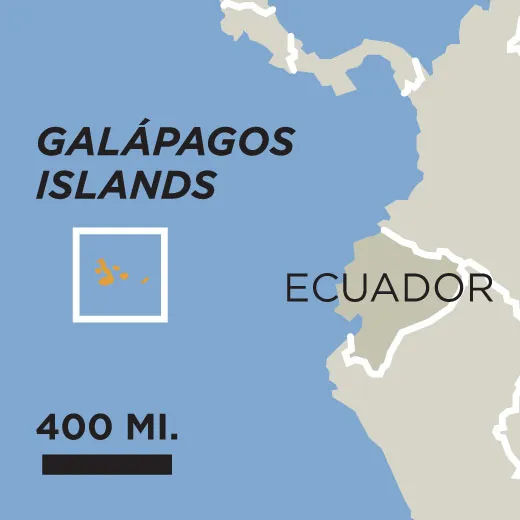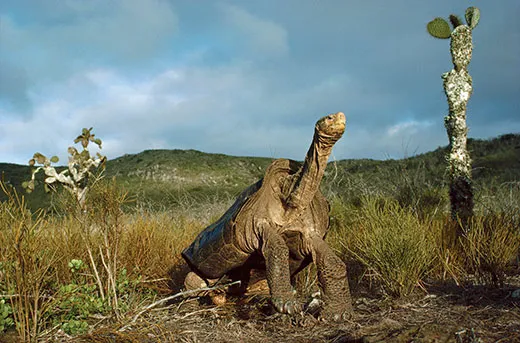Evolution World Tour: Galápagos Islands, Ecuador
The exotic locale, home to tortoises, cacti, iguanas and finches, was a source of inspiration for Darwin’s theory of evolution
In Charles Darwin’s day, the Galápagos Islands were perhaps the best place in the world to observe evidence of evolution by natural selection. They still are.
The 19 islands are the tips of volcanoes that began emerging from the ocean some five million years ago, steaming with fresh lava and devoid of life. The plants and animals that dwell there today are descended from castaways that arrived by sea or air. Finches and mockingbirds were blown off course by storms; iguanas floated on rafts of debris; and the tree-like scalesia plants are the overgrown progeny of sunflowers that made landfall via airborne seeds. It’s easy to study the diversity of species here in part because there aren’t all that many species to see.
The islands—separated from one another by distance, deep water and strong tides—isolated the newcomers, preventing many of the plants and animals from breeding with others of their kind that may have colonized other shores. With no place else to go, the Galápagos’ denizens adapted to conditions unique to their new homes.
Consider, for example, a tale of two tortoises. On Santa Cruz Island, with dense forests of scalesia, giant tortoises are built like rounded tanks that can crash through the underbrush. But over at Isabela Island, the dominant plant is the prickly pear cactus, a delicacy to giant tortoises. Some biologists have suggested the cactus adapted to this threat by growing taller, generation after generation, and acquiring a bark-like covering at tortoise-eye level. The tortoises, in turn, apparently evolved to have a notch in the shell behind their head, allowing the animals to stretch their long necks straight up to reach the lowest-hanging prickly pear pads.
The islands, which straddle the Equator, are still relatively pristine; 97 percent of the land is national park, and Ecuador limits who may live there and how many tourists may visit. “Galápagos are a wonderful place to study evolution, still, because, remarkably, several islands and their inhabitants are close to being in the fully natural state, with little or no influence of human activities,” says the evolutionary biologist and Princeton University professor emeritus Peter Grant who, with his wife, Rosemary (also a biologist), has been studying finches there since 1973. Their research has shown that natural selection is frequently at work in the Galápagos: After a drought, finches with larger beaks were able to eat tough seeds and survive; their offspring became predominant. After a particularly rainy year, softer seeds proliferated and smaller-beaked finches were more likely to survive. Grant recommends that a newcomer to the islands “be alert to differences between obviously related organisms” and visit at least two islands to appreciate how descendants of the same founder species adapted to different environments.
Darwin himself was a newcomer to the islands in 1835. On San Cristóbal, a statue of him overlooks the harbor where the HMS Beagle first anchored. Darwin served as the ship’s naturalist on its five-year voyage around the world. He’s depicted not as an eminent scholar with a long white beard, but as a young explorer of 26, tall and strong, engrossed in thought, out on an around-the-world adventure and noticing strange things. Janet Browne, a Darwin biographer, points out that he had “no sudden ‘eureka’ moment” while exploring the Galápagos, but the birds and other species he collected there “unsettled and intrigued him.”
Only after consulting with an ornithologist in London did Darwin realize that birds with very different beaks that he originally thought were from different lineages were all, in fact, closely related species of finch. He began to appreciate what he described in The Voyage of the Beagle as “the most remarkable feature in the natural history of this archipelago; it is, that the different islands to a considerable extent are inhabited by a different set of beings.” That realization led him to the greatest insight in the history of biology: Living things survive only if they can master their habitat; those that are best adapted to a new environment will reproduce and pass on their adaptations.
If Darwin hadn’t discovered evolution by natural selection, someone else would have. In fact, Alfred Russel Wallace drew on observations from the Malay Archipelago to come to the same realization. But seeing these islands as Darwin saw them can give you a better appreciation of his genius. As Peter Grant points out, the islands are “a place to let the mind wander and imagine what it must have been like for Charles Darwin to visit with his worldview, curiosity and unknown future.”
The Galápagos are also a stunning travel destination. Volcanic rock is twisted into bizarre spires and caves; the ocean is clean and teeming with life. Few predators live on the islands, so many species have lost their fear, making them easy to observe. (This, in itself, is favorable to survival, since being skittish just gets in the way of feeding and reproducing.) Blue-footed boobies perform goofy mating dances; frigate birds with seven-foot wingspans reel like pterodactyls in the sky; sea lions and marine iguanas swim curious loops around snorkelers. Depending on the season, air and ocean currents can come from any direction, and over millions of years they have deposited plants and animals from around the world. The only penguins north of the Equator are found in the Galápagos, and in one of the oddest neighborhoods in all of ornithology, they live on Isabela next door to a resident population of flamingos.
Visitors may feel an additional kinship with Darwin when it comes time to leave the islands. “I ought, perhaps, to be thankful that I obtained sufficient materials to establish this most remarkable fact in the distribution of organic beings,” he wrote in The Voyage of the Beagle. But he wished he’d had more time there. “It is the fate of most voyagers, no sooner to discover what is most interesting in any locality, than they are hurried from it.”
/https://tf-cmsv2-smithsonianmag-media.s3.amazonaws.com/accounts/headshot/laura-helmuth-240.jpg)


/https://tf-cmsv2-smithsonianmag-media.s3.amazonaws.com/accounts/headshot/laura-helmuth-240.jpg)